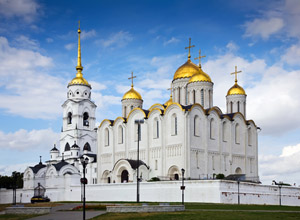Golden Ring, Russia

"Golden Ring" - these two words unite a group of ancient Russian towns to the north-east from Moscow. As maps show, the towns, making a curved line, lock up in Moscow. These ancient towns, which have been experiencing a long-long life full of interesting and fascinating events, rises and falls, preserve the memory about the most important and significant events in the Russian history. In our days the towns are often called "museums under open sky" where the unique monuments of Russian architecture of the 12th-17th centuries are collected, reminding about the dramatic events and fabulous people.
Vladimir
Vladimir, one of the Russia's oldest towns, bears the name of its founder Prince Vladimir Monomach. At first a fortress was built on the high bank of the Klyazma River in 1108. It soon grew into a town which rapidly expanded to become the capital of North-Eastern Russia as early as the 12th century. Its unique architectural masterpieces together with its cultural and artistic monuments betoken a profound spiritual life of the Russian people, the artistry of the Russian builders, painters and craftsmen. The main entrance to the city is guarded by the Golden Gate (1164). The walls of the disitinguished-looking Assumption Cathedral (1158-1161) carry the inimitable frescoes of Andrei Rublev. The Cathedral of Dmitry (1197) has a wondrously festive look with its intricate lace of the carved stone bas-reliefs. Not far from Vladimir the majestic and unique Church of the Intercession on the Nerl (1165) often called "the miracle of poetry in the stone" is situated.
Suzdal
Suzdal, first mentioned in chronicles in 1024, is considered to be one of the oldest and the best preserved Russian towns. No other town possesses as many splendid specimens of the Russian architecture of different epochs whilst retaining its original character and appearance: the Suzdal Kremlin with the sublime Cathedral of the Nativity of Our Lady (13-16th century), the Bishop's Palace (the former residence of the local clerical sovereigns built on the border of the 17th an 18th centuries), Spaso-Yevfimievsky Monastery (16-17th century), the Convent of the Intercession (16-18th century) and many others, The Golden Apple that is the honorary prize of the International Federation of Travel Journalists and Writers was awarded to Suzdal in 1983 for preserving and restoring the cultural monuments and using them in the interests of tourism.
Kostroma
Being nearly the same age as Moscow, Kostroma played a particular role in the Russian history as the birthplace of the Romanov Dynasty. In 1613 the boyars gathering at the Ipatiev Monastery blessed the young Mikhail Romanov to become the Tzar of Russia. Kostroma has preserved its peculiar image of a Russian city. The buildings of the Trade Galleries is the pride of Kostroma ranked among the best architectural monuments in Russia. Kostroma is also famous for its Fire-watch Tower (the symbol of the town) and ancient churches like the Church of the Resurrection with the 16th century iconostasis and the Epiphany-Anatasian Convent containing the holy "Federovskaya" icon of the Virgin believed to perform miracles. The contemporary Kostroma is a picturesque city with a strong historical atmosphere.
Yaroslavl
Many poetic pages have been devoted to Yaroslavl, to the city's inimitable architecture, the heroic past of the city and its famous craftsmen and stone-masons, potters and blacksmiths, painters and sculptors. They created the numerous churches each one of which immerses the contemporary visitors with striking and original beauty. This city developed a splendid culture of its own which merited its place in the history of Russia along with ancient Kiev, Novgorod and Moscow.
Yaroslavl today is a large city, but the original and extremely picturesque corners of the ancient Yaroslavl are still preserved. The entire panorama of the Kotorosl embankment consists of a chain of magnificent, unique churches culminating in the monumental and majestic ensemble of the white-stone Spaso-Preobrazhensky Monastery behind which rises the fine red-brick silhuette od the Church of the Apparition of Christ which its iridescent tile decorations. The ancient Spaso-Preobrazhensky Monastery now houses one of the most extensive museums of early Russian architecture, icon painting, ethnography and folk arts.
Rostov Veliky
This is a real germ of the Golden Ring with an amazingly well preserved ensemble of the Kremlin and the old historical centre located on the picturesque coast of Nero Lake. According to the chronicles Rostov the Great was founded in the 9th century. Starting with 1207 Rostov became a principality and after joining Moscow in 1474 it became a religious centre for the Moscow principality. The Rostov Kremlin which is one of the most impressive monuments of the Golden Ring was built in the 17th century as the Metropolitan's residence. Today the Kremlin houses a museum exhibiting the furnishing of the Metropolitans' dining-room and study, the icons of the 15017th centuries, and the famous Rostov enamels. The architectural monuments of Rostov include the Cathedral of the Assumption (early 16th century) and the Bell Tower (1682-1687). The largest of the famous Rostov bells weights 32,000 kg and the sound of its chimes could be heard at the distance of 20 km from the town.
Sergiev Posad (Former Zagorsk)
The town of Sergiev Posad got its name from Saint Serguis who was born in the neighbouring town of Radonezh and in the middle of the 14th century founded the largest and the most famous Russian monastery. That monastery known as the Holy Trinity-St. Sergius Lavra (the word "lavra" in Greek means the most significant monastery) is now something like a Russian Vatican. The place holds the Theological Seminary, the largest library of religious literature, the famous icons, historical and artistic treasures. The architectural complex of Trinity-St. Sergius Lavra was developed in the course of several centuries. The oldest church on its territory is the Holy Trinity Cathedral (1422-1423) famous for its icons painted by the renowned ion painter Andrei Rublev and the 17th century frescoes.